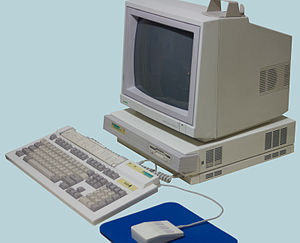Acorn Archimedes
 |
|

Archimedes 400/1 series computer: note the standard grey function keys on the keyboard; on BBC branded models, the function keys were red
|
|
| Developer | Acorn Computers Ltd |
|---|---|
| Type | Personal computer or home computer |
| Generation | Fourth generation |
| Release date | June 1987 |
| Introductory price | 800 GBP (circa 2,000 GBP today) |
| Discontinued | Mid-1990s |
| Operating system | RISC OS or RISC iX |
| CPU | ARM |
| Memory | 512 kB–16 MB |
The Acorn Archimedes is a family of personal computers designed by Acorn Computers Ltd in Cambridge, England and sold in the late-1980s to mid-1990s, their first general purpose home computer based on their own ARM architecture (then the CPU and architecture was known as Acorn RISC Machine, or ARM, that later became one of the most widely used CPU architectures in the world, e.g. used in most smartphones). The first Archimedes was launched in 1987.
ARM's RISC design – 32-bit CPU (26-bit addressing), running at 8 MHz, was stated as running at 4.5+ MIPS, which provided a significant upgrade from 8-bit home computers, such as Acorn's previous ones. Claims of being the fastest micro in the world and running at 18 MIPS were also made during tests.
The models in the family either omitted the Acorn or Archimedes part of the name, with the first models named "BBC Archimedes", while the name "Acorn Archimedes" is commonly used to describe any of Acorn's contemporary designs based on the same architecture. While the computers are no longer sold, computers such as the Raspberry Pi can still run its operating system, RISC OS (at least later versions) as they use ARM chips that are (mostly) compatible.
The Acorn Archimedes was the first RISC-based home computer. The first models were released in June 1987, as the 300 and 400 series. The 400 series included four expansion slots (although a two slot backplane could be added to the 300 series as an official upgrade, and third parties produced their own 4-slot backplanes) and an ST506 controller for an internal hard drive. Both models included the Arthur operating system (later replaced by RISC OS as a paid-for upgrade), BBC BASIC programming language and an emulator for Acorn's earlier BBC Micro, and were mounted in two-part cases with a small central unit, monitor on top, and a separate keyboard and three-button mouse (the middle one, used for pop-up context menus of the operating system). All models featured eight channel 8-bit stereo sound (time-multiplexed in software to the one channel the hardware provided, with the software also providing volume control – that was easier – as the sound was logarithmic) and were capable of displaying 256 colours on screen.
...
Wikipedia
